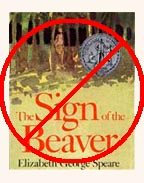 I love the book, Sign of the Beaver, by Elizabeth George Speare. I think it does a good job presenting the interactions of Native Americans and pioneers without condescension. My Native American unit has grown out of some comments my students made when we were reading the book. The main character, Matt- a twelve year-old boy, has had his gun stolen, and his cabin ransacked by a bear. His father has gone to get his mother from Massachusets and bring her to Maine. Matt is left with nothing to eat but fish. He doesn’t even have salt to season his food with.
I love the book, Sign of the Beaver, by Elizabeth George Speare. I think it does a good job presenting the interactions of Native Americans and pioneers without condescension. My Native American unit has grown out of some comments my students made when we were reading the book. The main character, Matt- a twelve year-old boy, has had his gun stolen, and his cabin ransacked by a bear. His father has gone to get his mother from Massachusets and bring her to Maine. Matt is left with nothing to eat but fish. He doesn’t even have salt to season his food with.
Enter Andres, who raised his hand and asked, “Why doesn’t he just squeeze a little lemon on it. My dad says that’s all fish needs to taste good.”
I realized that I had neglected a lot of frontloading/accessing prior knowledge that the students needed to understand the story. But I also realized that my students had no idea what pioneer life was like. Thus began our yearly project where each student needs to learn a skill used by Native Americans or pioneers during this time. Students have milked cows and churned butter, made candles, and made spears and speared fish with them. It’s been eye-opening.
BUT. There are those who dislike the book. Yesterday I handed my students an Internet article from Oyate, saying that Sign of the Beaver is a book to avoid. We read it together, discussed it, and then I had the students write their response to the article.
I was delighted when Philip said, “I didn’t even THINK of these questions when I read the book.” Many students were upset by the tone of the article. I believe they would have been convinced by a more logically presented article. Always interesting to teach evaluation!